Sustainable Color Development Strategies for Ancient Chinese Historical Commercial Areas: A Case Study of Suzhou’s Xueshi Street–Wuzounfang Street
Abstract
1. Introduction
- What is the current state of color disharmony in the commercial colors of the Xueshi Street–Wuzoufang Street historical district?;
- What issues are reflected in the existing color disharmony? Is there a difference between this situation and mainstream protection methods?;
- What implications do the research results have for future policy formulation and historical district protection practices in Suzhou?
2. Research Overview
2.1. Color Quantification Research in Historical Districts
2.2. Research on Color-Protection Practices in Historical Districts
2.3. Synthesis Conclusion and Research Hypothesis
2.3.1. Synthesis Conclusion
2.3.2. Research and Concept
3. Research Scope and Analysis Methods
3.1. Research Area
3.2. Overview of the Research Methods
3.3. Data Sources
3.4. Various Research Methods
3.4.1. Semantic Segmentation Method of Commercial Elements
3.4.2. Color Evaluation Method Based on CIELAB
3.4.3. Commercial Element Color Evaluation and Analysis Method
3.4.4. Negative Commercial Element Color-Extraction Method
4. Results
4.1. Evaluation of the Commercial Color Harmony in the District
4.2. Extraction of Negative Central Colors of Commercial Elements in the District
4.3. Analysis of the Experimental Results
4.3.1. Comprehensive Analysis of the Color Disharmony in Each Research Section
4.3.2. Comparative Analysis of Negative Colors Extracted via V-C-K with Prohibited Colors in Mainstream Color Guidelines (Based on the Munsell System)
5. Discussion
5.1. Reflections Based on the Current Situation
5.1.1. The Dual Trap of “Excessive Conflict” and “Excessive Dullness”
- (1)
- Conflict Caused by High Contrast
- (2)
- Dullness Caused by Low Value and Chroma
5.1.2. Authenticity and Vitality: Color Strategy from “Trade-Off” to “Mutual Promotion”
- (1)
- Protective Goals
- (2)
- Commercial Vitality Goals
5.2. Recommendations for Sustainable Color Development in Historical Blocks
5.2.1. Develop a Color Handbook at the Block Level: Use the ΔE00 Threshold to Control Block Colors
- (1)
- Main Color System ()
- (2)
- Auxiliary Color System ()
- (3)
- Accent Colors ( or slightly higher, usually not suitable for large areas)
- (4)
- Exempt Colors
5.2.2. Multi-Party Participation and Consensus Building
5.2.3. Incentive Measures for Merchants and Operators
5.2.4. Long-Term Maintenance and Feedback Mechanism
5.3. Research Limitations and Future Research Suggestions
- (1)
- Quantitative Research Methods Need to Be Combined with Richer Technical Means
- (2)
- The evaluation dimension at the level of subjective perception remains to be improved
- (3)
- The Measurement Angle of Historical Authenticity is Relatively Single
6. Conclusions
Author Contributions
Funding
Institutional Review Board Statement
Informed Consent Statement
Data Availability Statement
Acknowledgments
Conflicts of Interest
References
- Zhang, Y.; Wang, L. Research on the Protection and Renewal of Historical Blocks from the Perspective of Cultural Heritage Sustainability. Sustainability 2020, 12, 6234. [Google Scholar] [CrossRef]
- Liu, X.; Li, Y. Quantitative Analysis of Historical Block Color Based on Computer Vision Technology. Remote Sens. 2021, 13, 1937. [Google Scholar] [CrossRef]
- Chen, S.; Zhao, X. The Dilemma and Solution of Historical Block Protection in the Context of Commercialization. Heritage 2019, 2, 1247–1260. [Google Scholar]
- Wang, H.; Wu, Y. A New Method for Color Management in Historical Block Renovation: Combining Quantitative Analysis and Cultural Adaptation. Buildings 2022, 12, 923. [Google Scholar] [CrossRef]
- Li, J.; Zhang, H. Research on the Color Characteristics and Protection Strategies of Suzhou Ancient City Based on Big Data Analysis. Sensors 2023, 23, 1447. [Google Scholar] [CrossRef]
- Schmähling, F.; Wübbeler, G.; Krüger, U.; Ruggaber, B.; Schmidt, F.; Taubert, R.D.; Sperling, A.; Elster, C. Uncertainty evaluation and propagation for spectral measurements. Color Res. Appl. 2018, 43, 6–16. [Google Scholar] [CrossRef]
- Wen, Y.; Himeno, Y.; Chung, J. Potential conflicts between individual preferences and city color planning: A case study of Busan, South Korea. J. Asian Archit. Build. Eng. 2023, 22, 3649–3664. [Google Scholar] [CrossRef]
- Tian, T.; Wang, X.; Bai, Y. The Research of Architectural Color Evaluation Based on Image Processing. In Proceedings of the 2011 Fourth International Symposium on Computational Intelligence and Design, Hangzhou, China, 28–30 October 2011; IEEE: Hangzhou, China, 2011; pp. 290–293. [Google Scholar] [CrossRef]
- Sharma, G.; Wu, W.; Dalal, E.N. The CIEDE2000 color-difference formula: Implementation notes, supplementary test data, and mathematical observations. Color Res. Appl. 2005, 30, 21–30. [Google Scholar] [CrossRef]
- Khan, A.; Rauf, Z.; Sohail, A.; Khan, A.R.; Asif, H.; Asif, A.; Farooq, U. A survey of the vision transformers and their CNN-transformer based variants. Artif. Intell. Rev. 2023, 56, 2917–2970. [Google Scholar] [CrossRef]
- Miao, M.; Feng, L.; Wu, Y.; Zhu, R.; Xu, D. Color Authenticity for the Sustainable Development of Historical Areas: A Case Study of Shiquan. Sustainability 2024, 16, 2417. [Google Scholar] [CrossRef]
- Szabó, F.; Bodrogi, P.; Schanda, J. Experimental modeling of colour harmony. Color Res. Appl. 2010, 35, 34–49. [Google Scholar] [CrossRef]
- Zhong, T.; Ye, C.; Wang, Z.; Tang, G.; Zhang, W.; Ye, Y. City-Scale Mapping of Urban Façade Color Using Street-View Imagery. Remote Sens. 2021, 13, 1591. [Google Scholar] [CrossRef]
- Garcia-Codoñer, A.; Llopis Verdú, J.; Torres Barchino, A.; Villaplana Guillén, R.; Serra Lluch, J. Colour as a Structural Variable of Historical Urban Form. Color Res. Appl. 2009, 34, 253–265. [Google Scholar] [CrossRef]
- Lu, X.; Qin, H.; Wang, Z. Urban Color Characteristics of Cold City Harbin; Atlantis Press: Amsterdam, The Netherlands, 2016; p. 72. [Google Scholar]
- Zhuang, Y. The Color Planning Method of Shanghai New City Based on Big Data and Artificial Intelligence. Wirel. Commun. Mob. Comput. 2022, 2022, 1–6. [Google Scholar] [CrossRef]
- Elliot, A.J.; Maier, M.A. Color Psychology: Effects of Perceiving Color on Psychological Functioning in Humans. Annu. Rev. Psychol. 2014, 65, 95–120. [Google Scholar] [CrossRef]
- Nguyen, L.; Embrechts, J.-J.; Teller, J. Colour in the City: A Chromatic Typology for the Quantitative Analysis of Spatial Coherence. Landsc. Res. 2020, 45, 44–62. [Google Scholar] [CrossRef]
- Ding, M. Quantitative Contrast of Urban Agglomeration Colors Based on Image Clustering Algorithm: Case Study of the Xia-Zhang-Quan Metropolitan Area. Front. Archit. Res. 2021, 10, 692–700. [Google Scholar] [CrossRef]
- Bittermann, M.S.; Ciftcioglu, O. Visual perception with color for architectural aesthetics. In Proceedings of the IEEE Congress on Evolutionary Computation (CEC), Vancouver, BC, Canada, 24–29 July 2016; IEEE: Vancouver, BC, Canada, 2016; pp. 3909–3916. [Google Scholar] [CrossRef]
- Xu, Y.; Tong, H.; Liu, J.; Su, Y.; Li, M. An Assessment of the Urban Streetscape Using Multiscale Data and Semantic Segmentation in Jinan Old City, China. Buildings 2024, 14, 2687. [Google Scholar] [CrossRef]
- Gou, A.; Shi, B.; Wang, J.; Wang, H. Color preference and contributing factors of urban architecture based on the selection of color samples—Case study: Shanghai. Color Res. Appl. 2022, 47, 454–474. [Google Scholar] [CrossRef]
- Hu, K.; Xu, Z.; Wang, X.; Wang, Y.; Li, H.; Zhang, Y. Research on Street Color Environment Perception Based on CEP-KASS Framework. Buildings 2023, 13, 2649. [Google Scholar] [CrossRef]
- Zhou, X.; Cen, Q.; Qiu, H. Effects of urban waterfront park landscape elements on visual behavior and public preference: Evidence from eye-tracking experiments. Urban For. Urban Green. 2023, 82, 127889. [Google Scholar] [CrossRef]
- Department of Planning Government of Bermuda. The Traditional Building Guide: Advice for Preserving Bermuda’s Architectural Heritage; Department of Planning, Bermuda National Trust: Hamilton, Bermuda, 2002.
- De Martin, M.; Battaggia, S.; Ferronato, E.P.; Buzzo, C.; Bressan, A. Regolamento Edilizio di Venezia. 2019. Available online: https://www.comune.venezia.it/sites/comune.venezia.it/files/page/files/reg_edilizio_dal_15-02-2020.pdf (accessed on 19 February 2025).
- Kyoto City: Kyoto Landscape Guidelines. Available online: https://www.city.kyoto.lg.jp/tokei/page/0000281294.html (accessed on 15 February 2025).
- Tokyo Metropolitan Landscape Color Guidelines. Available online: https://www.toshiseibi.metro.tokyo.lg.jp/documents/d/toshiseibi/pdf_kenchiku_keikan_tokyo_color_guideline_01 (accessed on 15 February 2025).
- Osaka Prefecture Landscape Color Guidelines. Available online: https://www.pref.osaka.lg.jp/documents/21154/view_colour_guide_line.pdf (accessed on 19 February 2025).
- Nanjing City Color Control Guidelines. Available online: https://ghj.nanjing.gov.cn/ghbz/cssj/201802/P020181025424069659103.pdf (accessed on 19 February 2025).
- Busan Metropolitan City Urban Color Plan. Available online: https://www.busan.go.kr/depart/ahguideline (accessed on 19 February 2025).
- Francini, C. Florence Historic Center Management Plan. Available online: https://www.firenzepatrimoniomondiale.it/il-piano-di-gestione-2021-2022-e-piani-di-gestione-precedenti/ (accessed on 19 February 2025).
- Charleston Historical Preservation Plan and Guidelines. Available online: https://www.charleston-sc.gov/DocumentCenter/View/36078/City-of-Charleston-BAR-General-Guidelines-Booklet-2024?bidId= (accessed on 19 February 2025).
- Morsy, N.; Holiel, A.A. Color difference for shade determination with visual and instrumental methods: A systematic review and meta-analysis. Syst. Rev. 2023, 12, 95. [Google Scholar] [CrossRef] [PubMed]
- Luo, M.R.; Cui, G.; Rigg, B. The development of the CIE 2000 colour-difference formula: CIEDE2000. Color Res. Appl. 2001, 26, 340–350. [Google Scholar] [CrossRef]
- Lee, H.; Jung, J. Clustering-Based Plane Segmentation Neural Network for Urban Scene Modeling. Sensors 2021, 21, 8382. [Google Scholar] [CrossRef]
- Board of Architectural Review (BAR-L & BAR-S)|Charleston, SC—Official Website. Available online: https://www.charleston-sc.gov/293/Board-of-Architectural-Review-BAR-L-BAR- (accessed on 19 February 2025).
- Meiling, L.; Gongyan, L.; Shaoyun, X.; Yuexing, H.; Shu, Z. Decoupling foreground and background with Siamese ViT networks for weakly-supervised semantic segmentation. Neurocomputing 2024, 610, 128540. [Google Scholar] [CrossRef]
- Pereira, A.; Carvalho, P.; Coelho, G.; Côrte-Real, L. Efficient CIEDE2000-Based Color Similarity Decision for Computer Vision. IEEE Trans. Circuits Syst. Video Technol. 2020, 30, 2141–2154. [Google Scholar] [CrossRef]
- Mao, Z.; Rao, X.; Qi, F. Evaluation Research on Energy-Saving Retrofitting of Roofs of Traditional Wood-Structured Dwellings Based on the Continuation of Historical Features: A Case Study of Guangdu Village No. 280 Dwelling in Zhejiang. Sustainability 2024, 16, 2236. [Google Scholar] [CrossRef]
- Şahin Körmeçli, P. Accessibility of Urban Tourism in Historical Areas: Analysis of UNESCO World Heritage Sites in Safranbolu. Sustainability 2024, 16, 2485. [Google Scholar] [CrossRef]
- Mehrdad, C.; Hassan, S. A strategic development model for regeneration of urban historical cores: A case study of the historical fabric of Hamedan City. Land Use Policy 2022, 114, 105993. [Google Scholar] [CrossRef]
- Hong, X.; Ji, X.; Wu, Z. Architectural colour planning strategy and planning implementation evaluation of historical and cultural cities based on different urban zones in Xuzhou (China). Color Res. Appl. 2022, 47, 424–453. [Google Scholar] [CrossRef]
- Odetti, J.V. The study of color as a component of urban cultural construction: A theoretical reflection and methodological proposal. Color Res. Appl. 2023, 48, 453–467. [Google Scholar] [CrossRef]
- Yu, B. Understanding new colors in urban environments: Deciphering colors as semiotic resources. Color Res. Appl. 2023, 48, 567–577. [Google Scholar] [CrossRef]
- Wang, Y.; Xiu, C. Spatial Quality Evaluation of Historical Blocks Based on Street View Image Data: A Case Study of the Fangcheng District. Buildings 2023, 13, 1612. [Google Scholar] [CrossRef]
- Kang, B.; Lee, S.; Zou, S. Developing Sidewalk Inventory Data Using Street View Images. Sensors 2021, 21, 3300. [Google Scholar] [CrossRef]
- Yang, R.; Deng, X.; Shi, H.; Wang, Z.; He, H.; Xu, J.; Xiao, Y. A novel approach for assessing color harmony of historical buildings via street view image. Front. Archit. Res. 2024, 13, 764–775. [Google Scholar] [CrossRef]
- Justus, A.M. Coloristics comparative analysis of the historical centers’ architecture of the cities in the south of the Tyumen region. Architecture, Construction. Transport 2021, 2, 6–16. [Google Scholar]
- Zhang, J.; Fukuda, T.; Yabuki, N. A Large-Scale Measurement and Quantitative Analysis Method of Façade Color in the Urban Street Using Deep Learning. In Proceedings of the 2020 DigitalFUTURES; Yuan, P.F., Yao, J., Yan, C., Wang, X., Leach, N., Eds.; CDRF 2020; Springer: Singapore, 2021. [Google Scholar] [CrossRef]
- Sun, L.; Tan, W.; Ren, Y.; Ji, X.; Wang, Z.; Li, P. Research on Visual Comfort of Underground Commercial Streets’ Pavement in China on the Basis of Virtual Simulation. Int. J. Pattern Recognit. Artif. Intell. 2020, 34, 2050005. [Google Scholar] [CrossRef]
- Wang, M.; Vermeulen, F. Life between Buildings from a Street View Image: What Do Big Data Analytics Reveal about Neighbourhood Organisational Vitality? Urban Stud. 2020, 1–22. [Google Scholar] [CrossRef]
- Ou, L.-C.; Luo, M.R.; Woodcock, A.; Wright, A.B. A Study of Colour Emotion and Colour Preference. Part I: Colour Emotions for Single Colours. Color Res. Appl. 2004, 29, 232–240. [Google Scholar] [CrossRef]
- Chen, N.; Xu, X.; Tan, M.; Wang, X. A Spatial Analysis of Urban Color Harmony in Five Global Metropolises. J. Resour. Ecol. 2022, 13, 238–246. [Google Scholar] [CrossRef]
- Liu, Y.; Kang, J. Visual Comfort Analysis of Urban Building Color Attributes in Haze Weather. J. Harbin Inst. Technol. 2018, 50, 167–173. [Google Scholar] [CrossRef]
- Caivano, J.L. Research on Color in Architecture and Environmental Design: Brief History, Current Developments, and Possible Future. Color Res. Appl. 2006, 31, 350–363. [Google Scholar] [CrossRef]
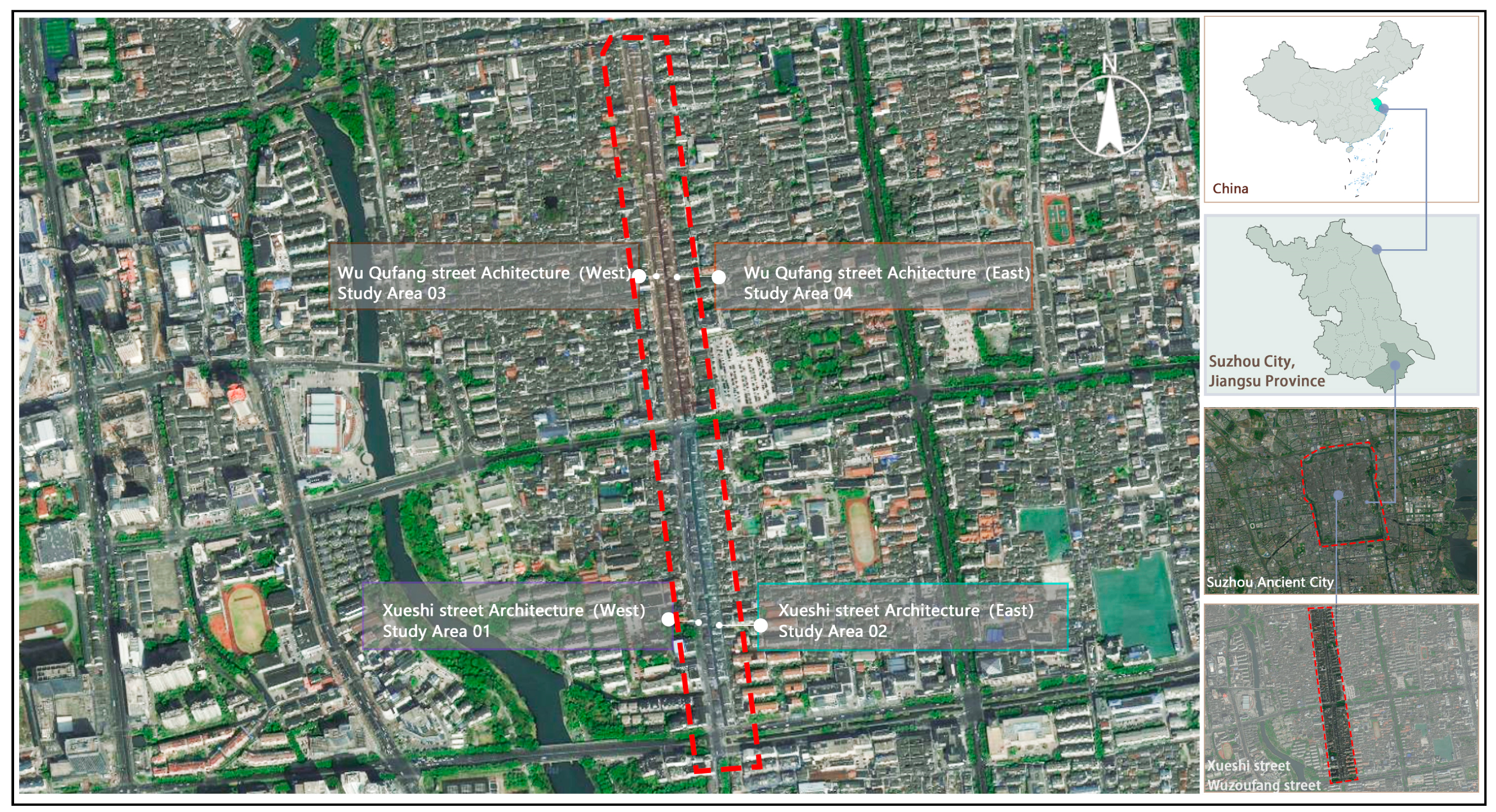


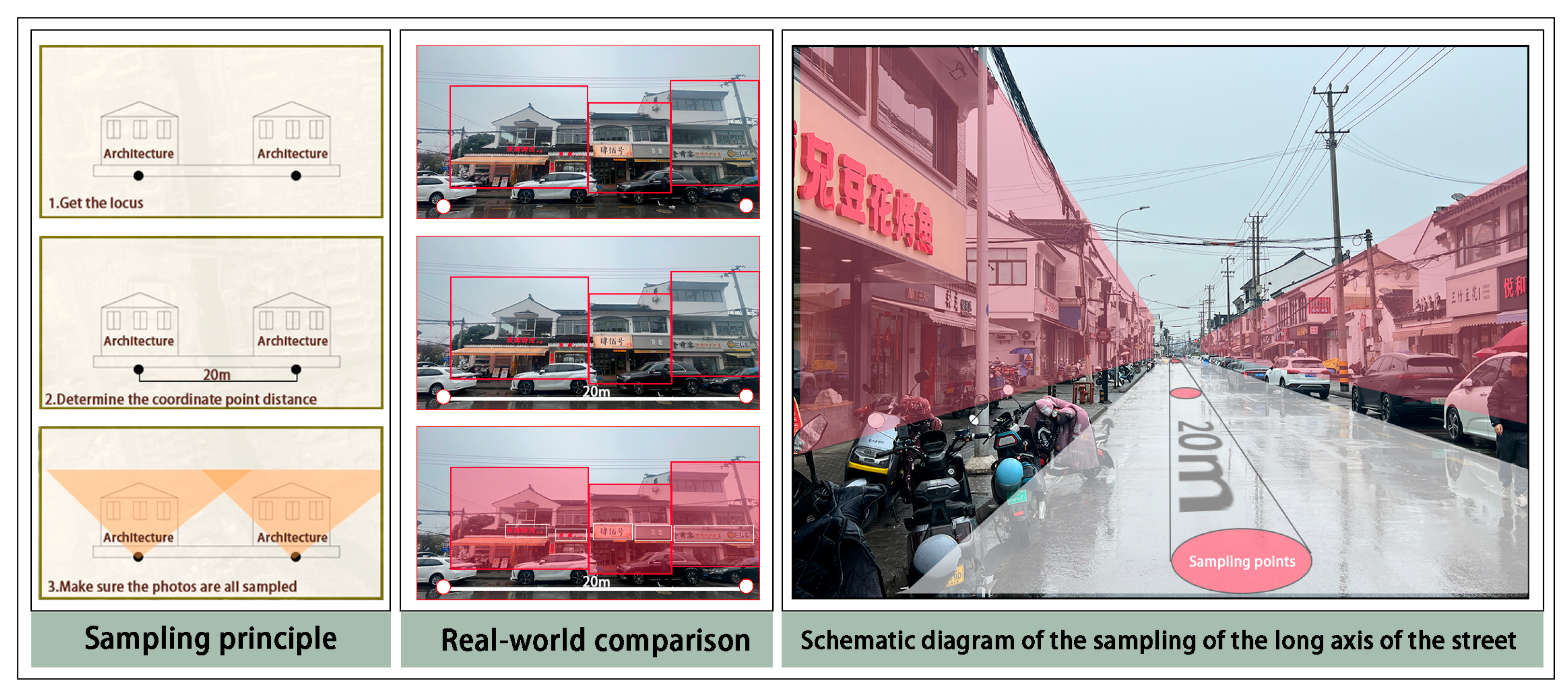


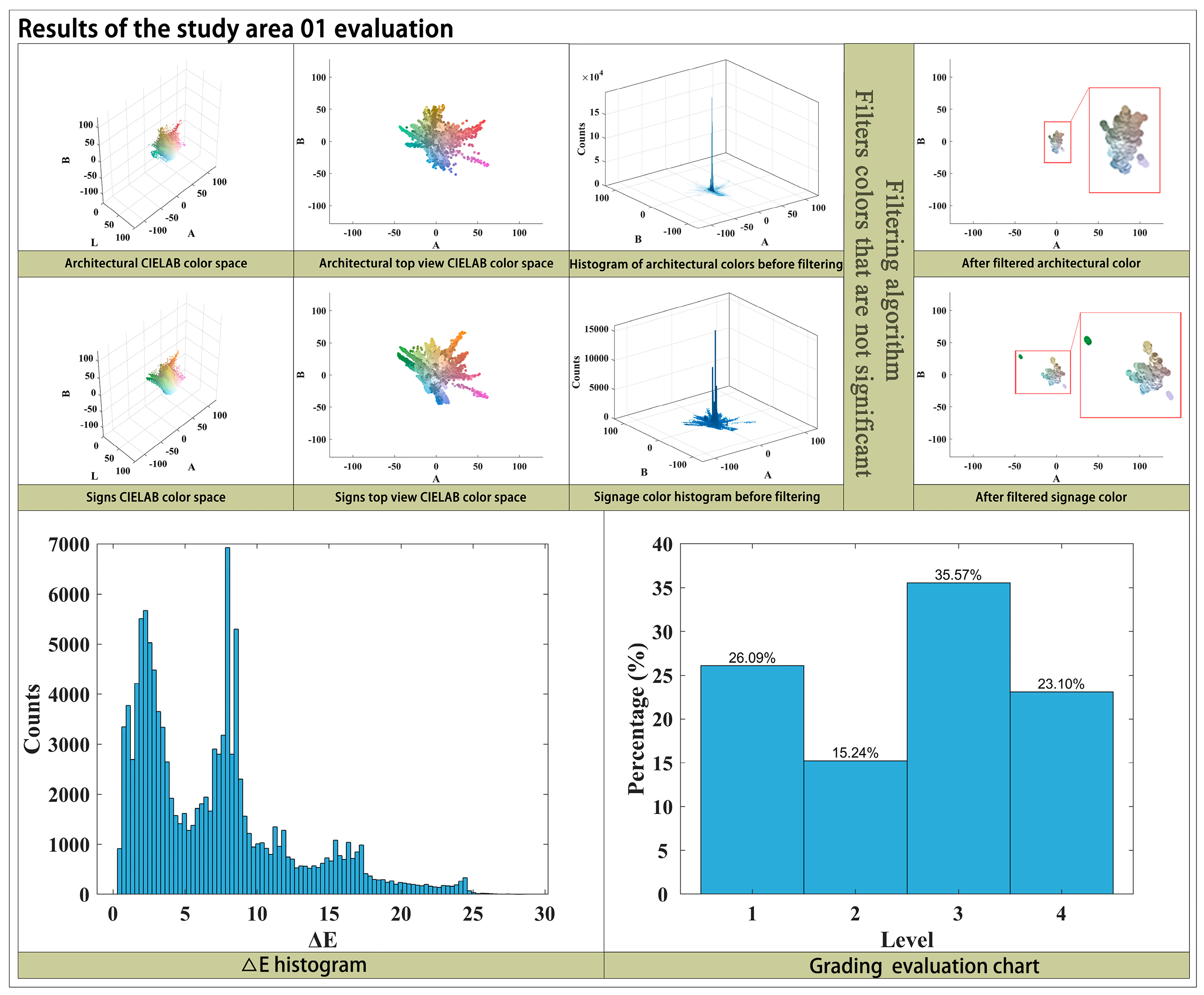
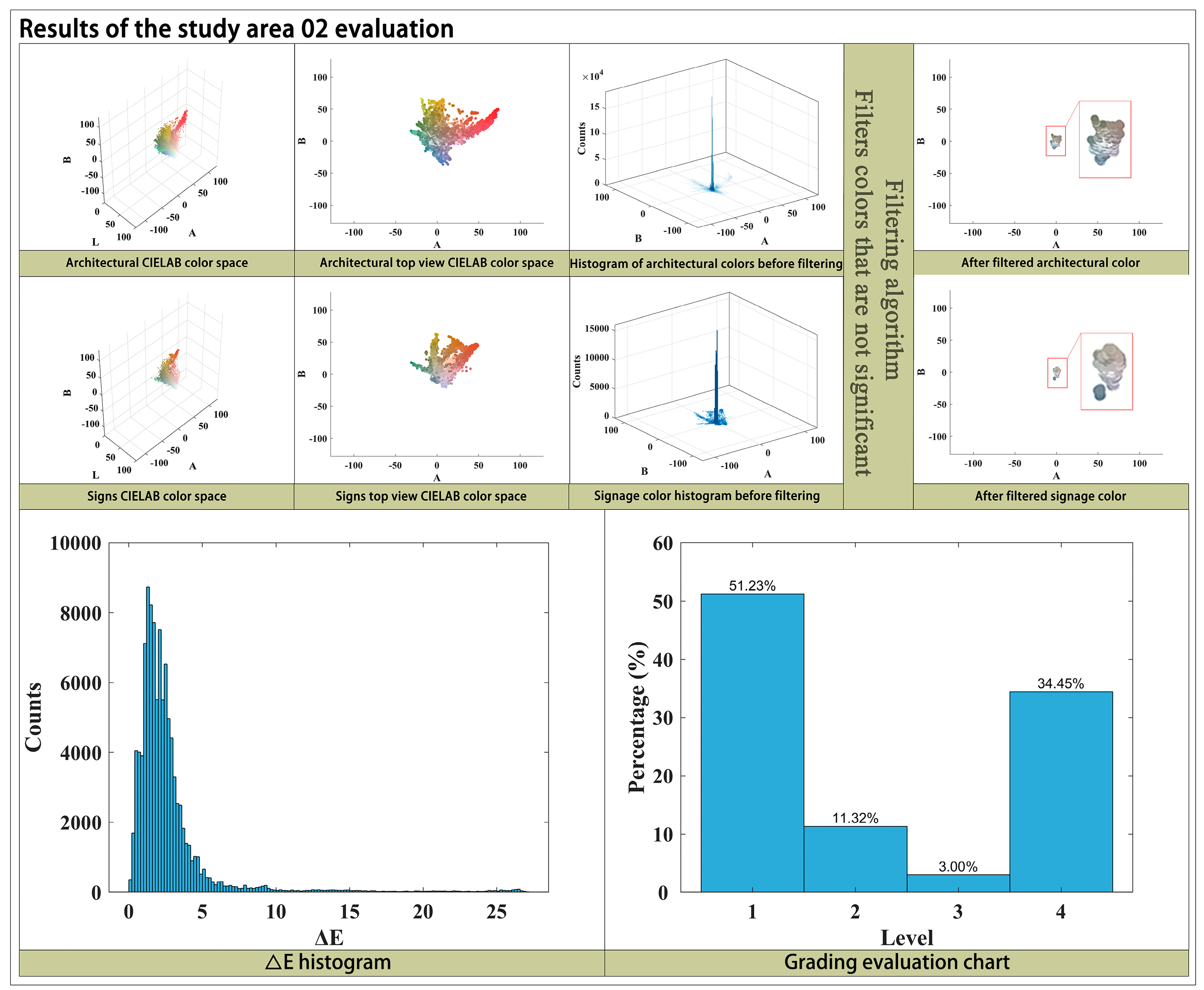
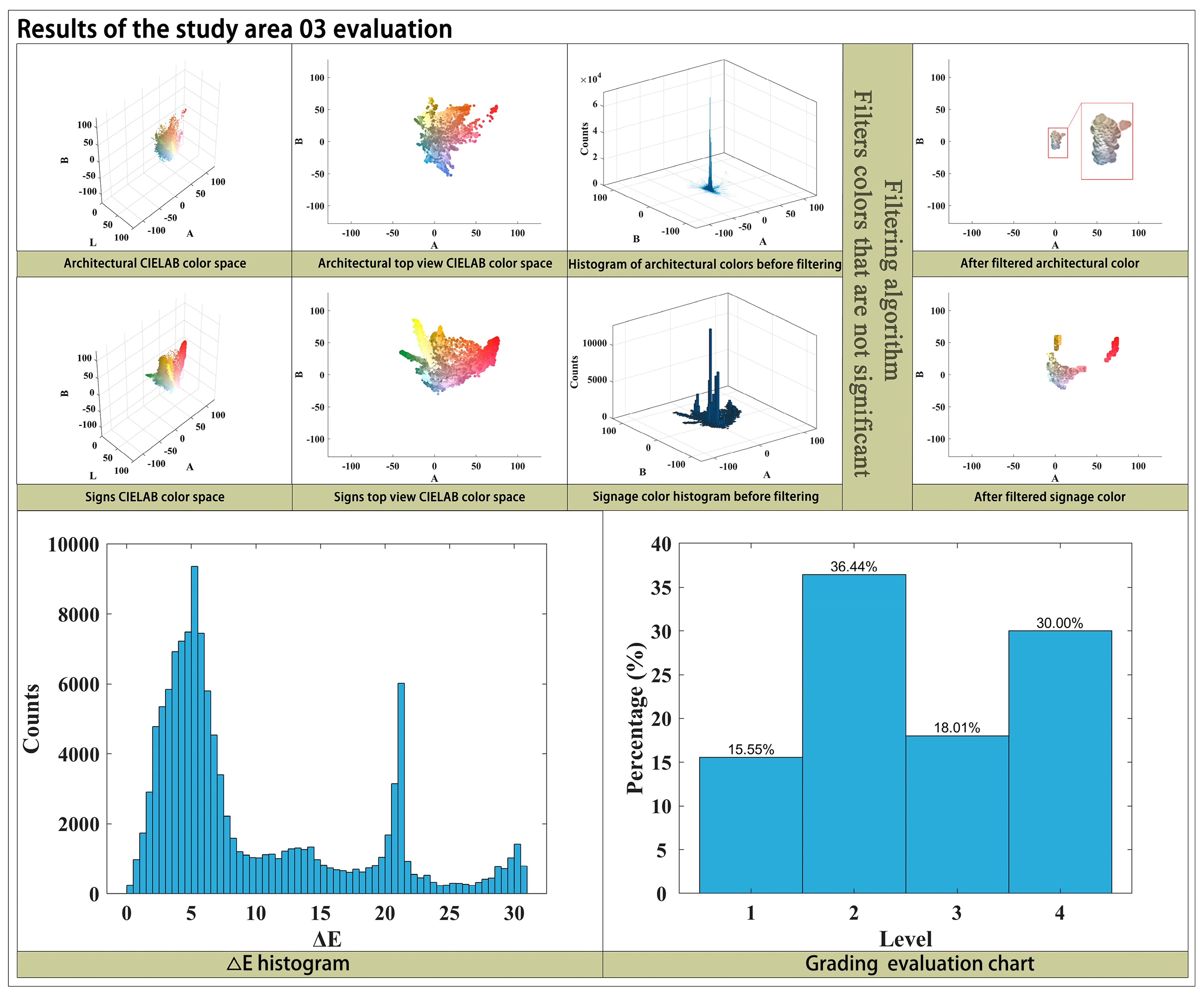





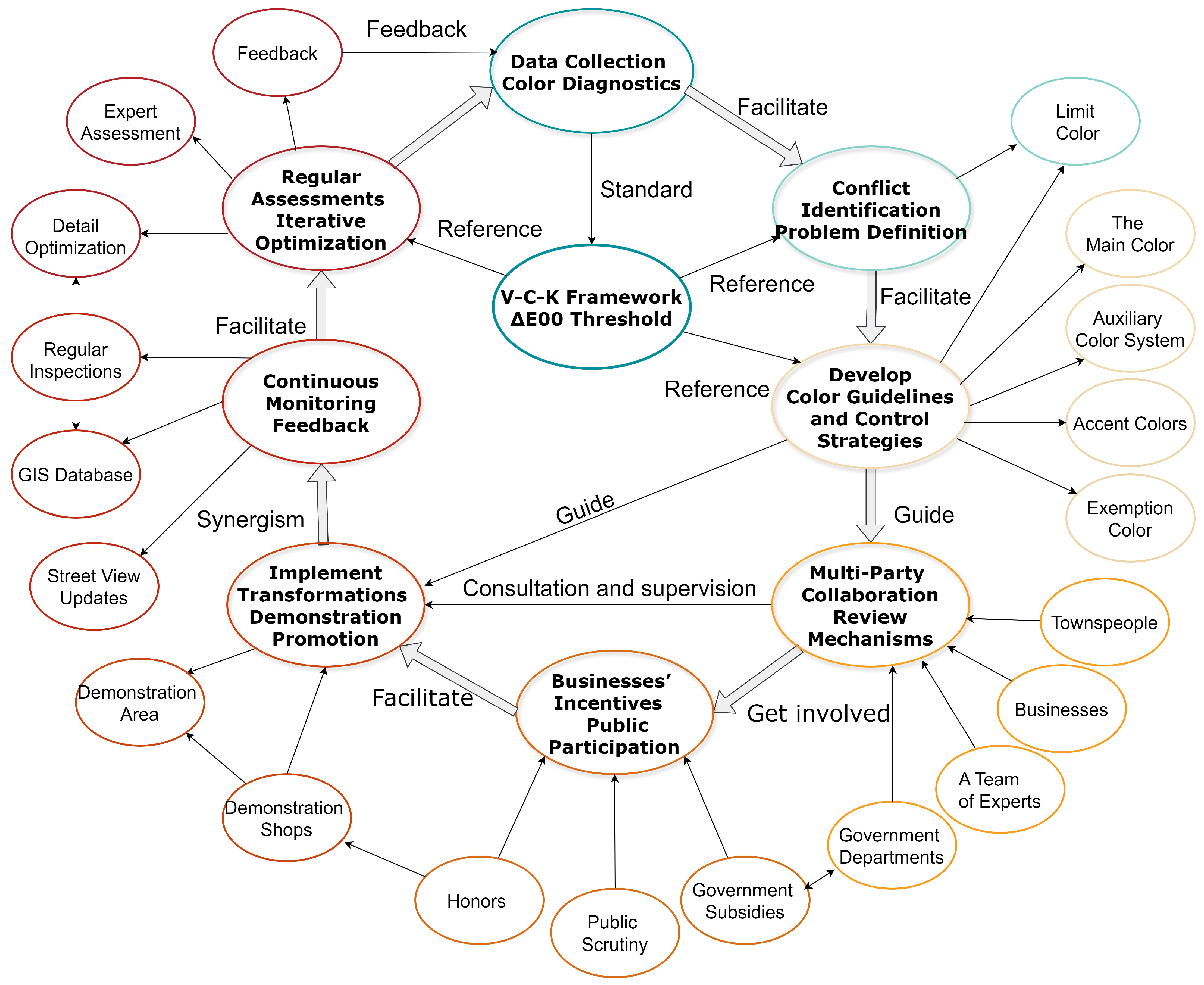
| Classification | Quantification Method Name | Technical Features and Empirical Evaluation | Related Studies Utilizing This Method |
|---|---|---|---|
| Experience-driven | Manual color card comparison | Method features: Manual color matching using standard color cards such as Munsell and GB/T15608. Empirical evaluation: Actual measurement error converted to (time consumption per building ≥ 3 h), subjective error rate approximately 35%. | (Garcia-Codoner et al., 2009 [14]): Analysis method for color structure in historical districts. (Lu et al., 2017 [15]): Adaptation modeling of color cards in cold cities. (Zhuang, 2022 [16]): Verification of color card coverage. |
| Visual color annotation | Method features: Non-standardized classification relying on cultural experience descriptions (e.g., “off-white” and “grayish-blue”) [17]. Empirical results: High controversy rate in color descriptions (≥40%) [7]. | (Elliot & Maier, 2014 [17]): Study on the relationships between color, emotion, and culture. (Wen et al., 2023 [7]): Case study on public preference and planning practice conflicts. | |
| Computer-aided | HSV + K-means | Method features: Layered optimization in HSV color space + K-means unsupervised clustering. Empirical evaluation: Main color recognition error converted to . | (Tian et al., 2011): Method for reducing color redundancy in facades [8]. (Nguyen et al., 2020 [18]): Analysis of color entropy in HSV models. (Ding, 2021 [19]): Comparison of the main colors in the Xiamen–Zhangzhou–Quanzhou urban cluster. |
| CIELAB color difference calculation | Method features: Simplified evaluation method based on linear color difference formula [12]. Empirical evaluation: Hue difference error in the blue region converted to . | (Bittermann et al., 2016): Fuzzy inference network [20]. | |
| Intelligent integration | SegNet semantic segmentation | Method features: Lightweight segmentation (model parameters < 50 MB), suitable for mobile deployment [21]. Empirical evaluation: Insufficient recognition of small targets [22]. | (Xu et al., 2024): Urban streetscape assessment in Jinan’s old city [21]. (Hu et al., 2023): Capture and analysis of visual elements and color data from Baidu street view images (BSVI) [23]. |
| CIEDE2000 + K-means clustering | Method features: CIE perceptual optimization color difference formula + K-means clustering for main color tones [9]. Empirical evaluation: Recognition rate of conflict areas of 93%, with a 41% increase in color harmony post-regulation [11]. | (Hu et al., 2023): CEP-KASS environmental comfort assessment model [23]. (Miao et al., 2024): Fine management strategies for historical districts [11]. | |
| Multi-level fusion analysis | Method features: Layered modeling using HSV/CIELAB + POI data fusion [13]. Empirical evaluation: Harmony prediction accuracy , significant increase in commercial diversity index [13]. | (Zhou et al., 2023): Constructing a “main–auxiliary–accessory” hierarchical model logic [24]. (Zhang et al., 2021): Framework for analyzing color–function synergy [13]. |
| Classification | Core Protection Principles | Main Management Methods | Technical Tools/Standards | Management Mechanism | Technical Limitations and Optimization Directions |
|---|---|---|---|---|---|
| Kyoto (Japan) | Maintain traditional black, gray, and brown tones, prohibit high-saturation colors; harmonize the colors of new and old buildings | Graded control (historical districts, roadside areas, etc.); hue–chroma threshold limits for advertising; dynamic threshold adjustment (view distance-based control) | Munsell color system; JIS Standards | Tripartite collaboration (government–experts–businesses); certification subsidies + fines | High craft costs; rigidity leading to decreased recognizability → increase exemption clauses, traditional material subsidy fund |
| Osaka (Japan) | Hue circle control based on JIS standards; prohibit high chroma (C > 5) and extreme colors (pure black, high-purity primary colors) | Hue gradient control (main hues in YR–RYB range); material–color value binding (wood corresponds to 5Y4/3.5, glass curtain wall to 2.5G5/1); physical color board JIS certification testing | JIS Z8721 Chromaticity System; Munsell system; Material Spectral Analysis | JIS certification laboratory testing; custom paints with historical color values | Rigid hue range (excludes trendy colors); high execution costs for small projects → relax hue limits for creative zones; reduce testing costs |
| Venice (Italy) | Prioritize natural tones, integrate with the environmental landscape; differentiate between public and private buildings | Prohibit modern bright colors; use lime mortar and mineral pigments; building type-specific color schemes | Historical color spectrum restoration; spectrophotometer | Strict approval processes; regional color schemes (cool tones by the water, warm tones inland) | Insufficient material aging simulation; reliance on subjective restoration → strengthen dynamic monitoring and adaptive adjustments |
| Venice (Italy) | Prioritize natural tones, integrate with the environmental landscape; differentiate between public and private buildings | Prohibit modern bright colors; use lime mortar and mineral pigments; building type-specific color schemes | Historical color spectrum restoration; spectrophotometer | Strict approval processes; regional color schemes (cool tones by the water, warm tones inland) | Insufficient material aging simulation; reliance on subjective restoration → strengthen dynamic monitoring and adaptive adjustments |
| Busan (South Korea) | Main color–auxiliary color–emphasis color ratio (7:2:1); match geographical areas (waterfront, inland, mountains) | Color area ratio control; HSV encoding analysis; high brightness for waterfront, low brightness for inland | Munsell system; CIELab Color Space; Standardized Color Card (KSA0011) | GIS dynamic map monitoring; citizen participation in surveys and optimization | Data collection affected by weather; poor adaptability of static planning → introduce a dynamic color database |
| Bermuda | Traditional lime paints and naturally weathered tones; prohibit latex paint | Material restrictions (lime-based paints); standardized restoration processes; preserve original wood colors | Historical color spectrum restoration (ochre, verdigris); spectrophotometer | Development Control Committee approval; mandatory rectification of violations | Low paint durability; high manual maintenance costs → develop environmentally friendly and durable alternative materials |
| Nanjing (China) | “Wutong Su Cai” (Sycamore Plain Color) as the main tone; zoned control (along rivers, historical areas, etc.) | Digital twin simulation of long-term evolution; humid and hot environment compensation model; material reflectance control | CityColor3D Platform; Munsell system + Adaptive Climate Model | Dynamic adjustments for five types of zoning; glass curtain wall reflection monitoring | High pollution weather model missing; traditional craft standards difficult to meet → improve climate compensation algorithms |
| Tokyo (Japan) | Hue circle zoning and grading (historical areas YR system, business areas B/PB system); vertical color gradation for high-rise buildings | Circular color spectrum mapping + GIS verification; dynamic color buffering of electronic screens (increased chroma at night) | Munsell system; NCS Natural Color System; AI Color Difference Early Warning | Drone patrol inspections + “Color Bank” points system | Lack of supervision in small micro-spaces; innovation suppression → relax hue limits in creative zones; increase exemption policies |
| Charleston (USA) | Prohibit speculative restoration; ensure visual compatibility with adjacent buildings; preserve the original color of natural materials | Section microanalysis; spectral matching; accelerated aging tests for new materials | NCS/Munsell system; spectrophotometer | Building rating and grading review; community hearing system | Vague definitions lead to disputes; poor economic efficiency → clarify color difference thresholds; provide subsidies for traditional crafts |
| Florence (Italy) | Historical layered restoration (priority to 19th-century color spectrum); imitation mineral paints ΔE ≤ 2.0 | Section sampling + microscopic observation; VirtualChroma lighting simulation; trial of acrylic resin paints | Spectrophotometer (X-Rite SP6); CIEDE2000 Color Difference Formula | Three-level review + public hearings | Sampling damages structure; subjective restoration → promote non-destructive testing technologies |
| Standard Range | Evaluation Level | Interpretation |
|---|---|---|
| Interpretation | Ordinary people cannot see the difference with the naked eye. It can be determined that they are harmonious colors of the same kind. They can be used as the embodiment of harmonious colors in the evaluation part and as the main color in the recommended color part. | |
| More harmonious | Although the colors are different, the tones are the same. It can be used as a more harmonious color range when evaluating, and it is recommended to use it as a secondary color when matching colors. | |
| Less harmonious | It can be identified as different tones, which can be directly distinguished by the naked eye. It can be classified as a relatively discordant color range in evaluation. | |
| Extremely discordant | It represents another color, and there is no correlation between colors. |
| Research Section | RGB Value | Value | Chroma |
|---|---|---|---|
| 01 Research | 120.131.147 | 5.1 | 2.2 |
| 116.127.140 | 4.8 | 2.1 | |
| 129.127.144 | 5.4 | 2.8 | |
| 125.125.125 | 4.7 | <0.5 | |
| 139.128.71 | 6.0 | 5.3 | |
| 138.127.73 | 5.7 | 5.5 | |
| 142.129.74 | 6.3 | 6.1 | |
| 138.126.73 | 5.9 | 5.7 | |
| 02 Research | 251.50.52 | 5.2 | 16.8 |
| 153.80.95 | 4.5 | 12.1 | |
| 160.126.20 | 5.6 | 13.4 | |
| 159.130.46 | 5.8 | 11.2 | |
| 154.150.109 | 7.4 | 7.8 | |
| 138.127.73 | 5.5 | 6.4 | |
| 142.129.74 | 6.0 | 6.7 | |
| 138.126.73 | 5.7 | 6.0 | |
| 03 Research | 116.133.149 | 5.4 | 3.1 |
| 115.131.146 | 5.3 | 3.0 | |
| 108.124.139 | 4.8 | 2.6 | |
| 108.125.141 | 4.9 | 2.7 | |
| 111.124.141 | 5.0 | 2.8 | |
| 109.125.141 | 4.9 | 2.7 | |
| 106.123.139 | 4.7 | 2.5 | |
| 114.131.147 | 5.3 | 3.0 | |
| 04 Research | 186.208.190 | 7.6 | 4.7 |
| 172.198.214 | 7.4 | 6.0 | |
| 167.195.193 | 7.0 | 4.3 | |
| 224.217.172 | 8.3 | 4.1 | |
| 197.190.229 | 7.7 | 9.3 | |
| 158.198.190 | 7.3 | 5.4 | |
| 51.146.77 | 5.2 | 10.8 | |
| 192.181.160 | 7.2 | 3.8 |
Disclaimer/Publisher’s Note: The statements, opinions and data contained in all publications are solely those of the individual author(s) and contributor(s) and not of MDPI and/or the editor(s). MDPI and/or the editor(s) disclaim responsibility for any injury to people or property resulting from any ideas, methods, instructions or products referred to in the content. |
© 2025 by the authors. Licensee MDPI, Basel, Switzerland. This article is an open access article distributed under the terms and conditions of the Creative Commons Attribution (CC BY) license (https://creativecommons.org/licenses/by/4.0/).
Share and Cite
Feng, L.; Yu, G.; Miao, M.; Sun, J. Sustainable Color Development Strategies for Ancient Chinese Historical Commercial Areas: A Case Study of Suzhou’s Xueshi Street–Wuzounfang Street. Sustainability 2025, 17, 4756. https://doi.org/10.3390/su17114756
Feng L, Yu G, Miao M, Sun J. Sustainable Color Development Strategies for Ancient Chinese Historical Commercial Areas: A Case Study of Suzhou’s Xueshi Street–Wuzounfang Street. Sustainability. 2025; 17(11):4756. https://doi.org/10.3390/su17114756
Chicago/Turabian StyleFeng, Lyuhang, Guanchao Yu, Mingrui Miao, and Jiawei Sun. 2025. "Sustainable Color Development Strategies for Ancient Chinese Historical Commercial Areas: A Case Study of Suzhou’s Xueshi Street–Wuzounfang Street" Sustainability 17, no. 11: 4756. https://doi.org/10.3390/su17114756
APA StyleFeng, L., Yu, G., Miao, M., & Sun, J. (2025). Sustainable Color Development Strategies for Ancient Chinese Historical Commercial Areas: A Case Study of Suzhou’s Xueshi Street–Wuzounfang Street. Sustainability, 17(11), 4756. https://doi.org/10.3390/su17114756







